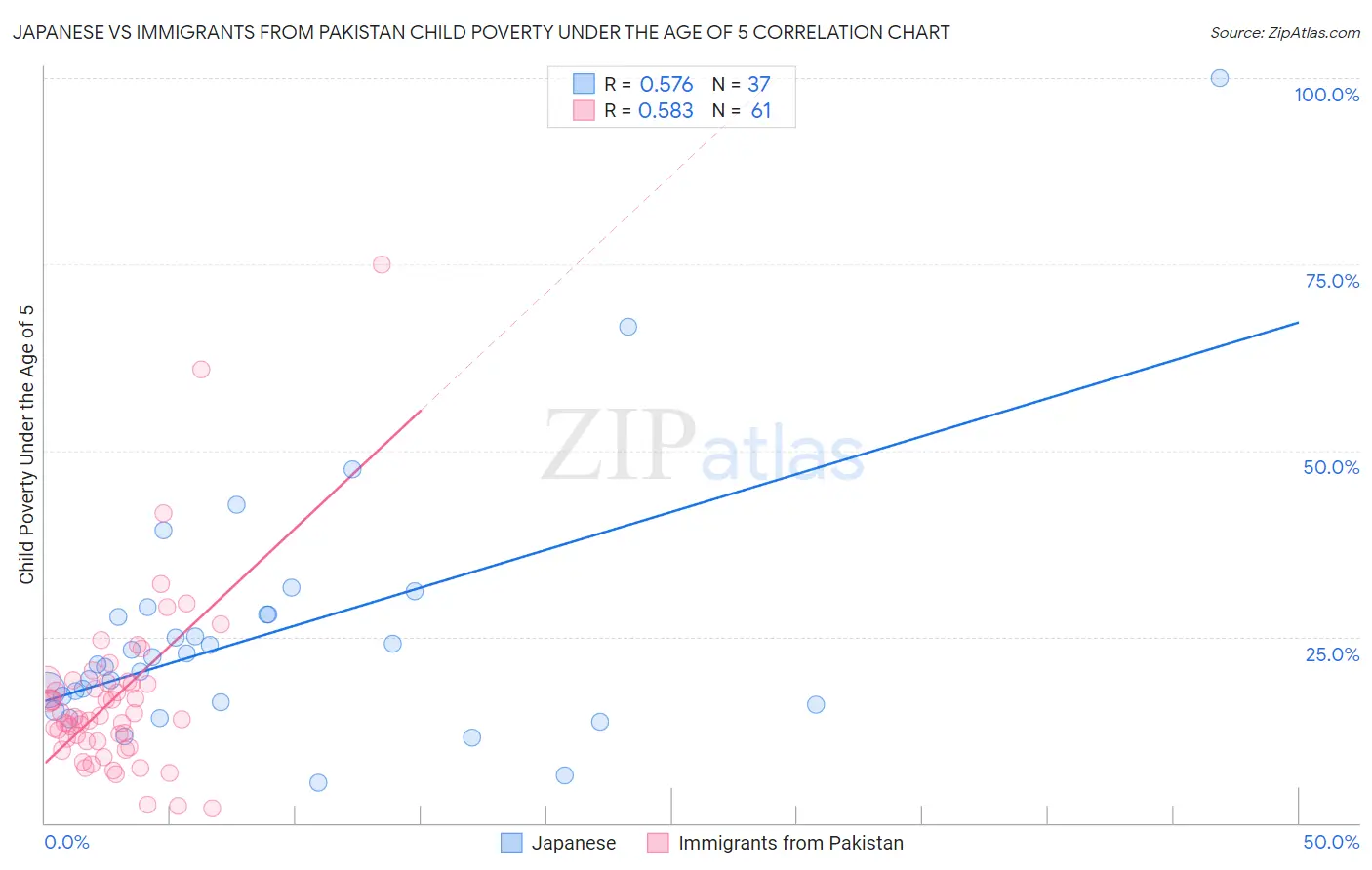Japanese vs Immigrants from Pakistan Child Poverty Under the Age of 5
COMPARE
Japanese
Immigrants from Pakistan
Child Poverty Under the Age of 5
Child Poverty Under the Age of 5 Comparison
Japanese
Immigrants from Pakistan
18.1%
CHILD POVERTY UNDER THE AGE OF 5
13.8/ 100
METRIC RATING
202nd/ 347
METRIC RANK
14.9%
CHILD POVERTY UNDER THE AGE OF 5
99.4/ 100
METRIC RATING
56th/ 347
METRIC RANK
Japanese vs Immigrants from Pakistan Child Poverty Under the Age of 5 Correlation Chart
The statistical analysis conducted on geographies consisting of 243,928,105 people shows a substantial positive correlation between the proportion of Japanese and poverty level among children under the age of 5 in the United States with a correlation coefficient (R) of 0.576 and weighted average of 18.1%. Similarly, the statistical analysis conducted on geographies consisting of 274,479,981 people shows a substantial positive correlation between the proportion of Immigrants from Pakistan and poverty level among children under the age of 5 in the United States with a correlation coefficient (R) of 0.583 and weighted average of 14.9%, a difference of 20.9%.

Child Poverty Under the Age of 5 Correlation Summary
| Measurement | Japanese | Immigrants from Pakistan |
| Minimum | 5.4% | 2.0% |
| Maximum | 100.0% | 75.0% |
| Range | 94.6% | 73.0% |
| Mean | 25.2% | 16.9% |
| Median | 21.3% | 14.3% |
| Interquartile 25% (IQ1) | 16.0% | 10.9% |
| Interquartile 75% (IQ3) | 28.1% | 18.9% |
| Interquartile Range (IQR) | 12.0% | 8.0% |
| Standard Deviation (Sample) | 17.1% | 12.0% |
| Standard Deviation (Population) | 16.9% | 11.9% |
Similar Demographics by Child Poverty Under the Age of 5
Demographics Similar to Japanese by Child Poverty Under the Age of 5
In terms of child poverty under the age of 5, the demographic groups most similar to Japanese are Ugandan (18.0%, a difference of 0.020%), Immigrants from Cambodia (18.1%, a difference of 0.020%), Iraqi (18.0%, a difference of 0.030%), Immigrants from Eastern Africa (18.1%, a difference of 0.080%), and Spaniard (18.1%, a difference of 0.21%).
| Demographics | Rating | Rank | Child Poverty Under the Age of 5 |
| Sierra Leoneans | 24.1 /100 | #195 | Fair 17.7% |
| Immigrants | Portugal | 22.2 /100 | #196 | Fair 17.8% |
| Immigrants | Kenya | 20.0 /100 | #197 | Fair 17.9% |
| Celtics | 18.3 /100 | #198 | Poor 17.9% |
| Hungarians | 18.3 /100 | #199 | Poor 17.9% |
| Iraqis | 14.0 /100 | #200 | Poor 18.0% |
| Ugandans | 13.9 /100 | #201 | Poor 18.0% |
| Japanese | 13.8 /100 | #202 | Poor 18.1% |
| Immigrants | Cambodia | 13.7 /100 | #203 | Poor 18.1% |
| Immigrants | Eastern Africa | 13.4 /100 | #204 | Poor 18.1% |
| Spaniards | 12.8 /100 | #205 | Poor 18.1% |
| Whites/Caucasians | 12.6 /100 | #206 | Poor 18.1% |
| Immigrants | Immigrants | 9.9 /100 | #207 | Tragic 18.2% |
| Scotch-Irish | 9.8 /100 | #208 | Tragic 18.2% |
| Spanish | 9.8 /100 | #209 | Tragic 18.2% |
Demographics Similar to Immigrants from Pakistan by Child Poverty Under the Age of 5
In terms of child poverty under the age of 5, the demographic groups most similar to Immigrants from Pakistan are Danish (14.9%, a difference of 0.070%), Egyptian (14.9%, a difference of 0.080%), Immigrants from Israel (14.9%, a difference of 0.13%), Swedish (15.0%, a difference of 0.13%), and Luxembourger (14.9%, a difference of 0.14%).
| Demographics | Rating | Rank | Child Poverty Under the Age of 5 |
| Immigrants | Bulgaria | 99.6 /100 | #49 | Exceptional 14.8% |
| Immigrants | Northern Europe | 99.6 /100 | #50 | Exceptional 14.8% |
| Estonians | 99.6 /100 | #51 | Exceptional 14.8% |
| Immigrants | Serbia | 99.5 /100 | #52 | Exceptional 14.9% |
| Luxembourgers | 99.4 /100 | #53 | Exceptional 14.9% |
| Immigrants | Israel | 99.4 /100 | #54 | Exceptional 14.9% |
| Danes | 99.4 /100 | #55 | Exceptional 14.9% |
| Immigrants | Pakistan | 99.4 /100 | #56 | Exceptional 14.9% |
| Egyptians | 99.4 /100 | #57 | Exceptional 14.9% |
| Swedes | 99.4 /100 | #58 | Exceptional 15.0% |
| Paraguayans | 99.4 /100 | #59 | Exceptional 15.0% |
| Immigrants | Russia | 99.3 /100 | #60 | Exceptional 15.0% |
| Immigrants | Poland | 99.1 /100 | #61 | Exceptional 15.1% |
| Immigrants | Eastern Europe | 99.1 /100 | #62 | Exceptional 15.1% |
| Immigrants | Europe | 99.1 /100 | #63 | Exceptional 15.1% |